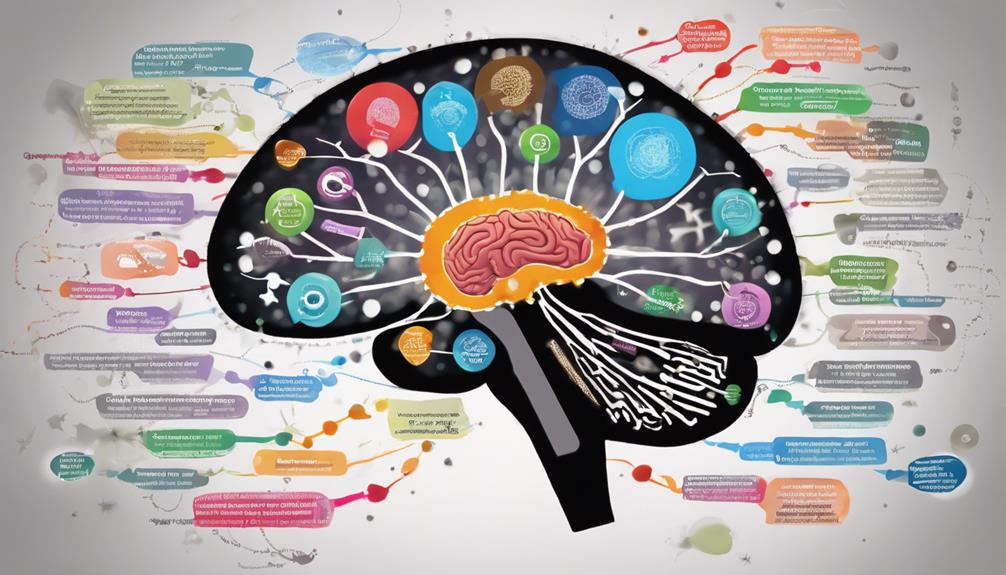To achieve holistic mind-body balance involves a blend of science and lifestyle adjustments. The key lies in comprehending the mind-body interconnection, enhancing physical health, nutrition, and exercise habits, and exploring techniques like meditation, yoga, and hypnosis. These methods promote synchronization between mental and physical well-being, contributing to reduced stress, improved immunity, heightened energy levels, and an overall sense of wellness. By incorporating these elements, individuals can pave the way to a harmonious state of being that nurtures both mind and body.
The Science Behind Mind-Body Connection

Understanding the intricate relationship between the mind and body is essential for exploring the science behind the mind-body connection. This connection is mediated by a complex network of neurological pathways that allow communication between the brain and the body.
One crucial aspect of this connection is emotional regulation, which plays a significant role in maintaining overall well-being.
Neurological pathways are the routes through which signals travel between the brain and the rest of the body, influencing various functions such as movement, perception, and emotional responses. These pathways are integral to how our thoughts and feelings impact our physical health.
Emotional regulation, the ability to manage and respond to emotions in a healthy way, is closely linked to these neurological pathways. When emotional regulation is compromised, it can lead to imbalances in the mind-body connection, affecting both mental and physical health.
Implementing Lifestyle Changes for Balance
To achieve holistic mind-body balance, incorporating lifestyle changes is crucial for promoting overall well-being and harmony between mental and physical health.
Two key components in achieving this balance are nutrition habits and exercise routines.
Nutrition plays a vital role in supporting both mental and physical health. Consuming a well-rounded diet rich in fruits, vegetables, whole grains, lean proteins, and healthy fats provides essential nutrients that support brain function, mood regulation, and overall physical well-being. Making conscious choices to fuel your body with nourishing foods can have a profound impact on your energy levels, mood stability, and cognitive function.
In addition to nutrition, incorporating regular exercise into your routine is essential for achieving holistic balance. Physical activity not only strengthens the body but also releases endorphins that boost mood and reduce stress. Finding an exercise routine that you enjoy, whether it's yoga, running, dancing, or weightlifting, can help you stay consistent and reap the benefits of improved physical and mental health.
Understanding the Power of Hypnosis

Exploring the profound influence of hypnosis can offer valuable insights into the interconnected nature of the mind and body.
Hypnosis is a powerful tool that can tap into the subconscious mind, enabling profound healing and transformation. By inducing altered states of consciousness, hypnosis allows individuals to access deeply rooted beliefs and emotions that may be impacting their physical and mental well-being.
The subconscious mind plays a crucial role in shaping our thoughts, behaviors, and overall health. Through hypnosis, individuals can address underlying issues, traumas, and patterns that are stored in the subconscious, leading to profound healing and personal growth. This process of subconscious healing can promote holistic well-being by aligning the mind and body in a harmonious way.
Moreover, hypnosis can facilitate a state of deep relaxation, helping individuals reduce stress, anxiety, and physical tension. By harnessing the power of altered states, hypnosis empowers individuals to reprogram their subconscious mind, fostering positive changes that support overall mind-body balance.
Techniques for Mind-Body Synchronization
Hypnosis is just one of the many techniques available for fostering mind-body synchronization, offering a unique avenue for individuals to tap into their subconscious and promote holistic well-being.
In addition to hypnosis, incorporating breathing exercises can be highly beneficial. Controlled breathing not only calms the mind but also helps in connecting with the body's rhythms, fostering a sense of harmony within.
Meditation techniques are another powerful tool for enhancing mind-body synchronization. By quieting the mind and focusing inward, individuals can cultivate a deeper awareness of their physical sensations and emotional state.
Furthermore, engaging in a yoga practice can significantly contribute to achieving holistic balance. Yoga combines physical postures, breathing exercises, and meditation, promoting flexibility, strength, and mental clarity.
Mindfulness activities, such as mindful eating or walking, can also aid in synchronizing the mind and body. These practices encourage individuals to be fully present in the moment, fostering a deeper connection to their physical selves and surroundings.
Benefits of Holistic Balance Achieved

Embracing holistic balance brings a multitude of physical, mental, and emotional benefits that enhance overall well-being. One of the significant advantages of achieving holistic balance is stress reduction. By incorporating practices that align the mind and body, individuals can experience a reduction in stress levels, leading to improved mental clarity and emotional stability.
Additionally, holistic balance has been linked to improved immunity. When the body is in a state of equilibrium, the immune system functions optimally, helping to ward off illnesses and infections more effectively.
Furthermore, holistic balance contributes to enhanced well-being. By nurturing the connection between the mind and body, individuals can experience a greater sense of overall wellness and fulfillment. This holistic approach also results in increased energy levels. When the body is in balance, energy flows more freely, providing individuals with the vitality and stamina needed to navigate daily challenges with ease.
Frequently Asked Questions
Can Genetics Affect Mind-Body Balance?
Genetic predispositions can influence mind-body balance, but environmental factors play a crucial role too. Understanding how genetics interact with lifestyle choices, stress levels, and mental health can help individuals achieve a holistic approach to well-being.
How Can Social Relationships Impact Holistic Balance?
Social relationships play a vital role in holistic balance. Emotional support from strong social connections can enhance overall well-being, reduce stress, and foster a sense of belonging. Nurturing these relationships is essential for achieving mind-body harmony.
Is Spirituality Important for Mind-Body Connection?
Spirituality plays a crucial role in fostering a strong mind-body connection. Engaging in spiritual practices and mindfulness techniques can help individuals center themselves, cultivate inner peace, and promote overall well-being by harmonizing mental, emotional, and physical aspects of health.
Can Past Trauma Hinder Achieving Holistic Balance?
Past trauma can indeed hinder achieving holistic balance by creating emotional wounds that impact both mind and body. Through dedicated emotional healing and the use of therapeutic techniques, individuals can work towards integrating past experiences and achieving a state of balance.
Are There Specific Foods That Enhance Mind-Body Synchronization?
In fostering mind-body synchronization, specific foods play a vital role. When combined with meditation benefits and tailored exercise routines, nutrient-dense options like leafy greens, berries, and omega-3 rich fish can enhance overall well-being and facilitate holistic balance.
Conclusion
In conclusion, achieving holistic mind-body balance is essential for overall well-being. By understanding the science behind the mind-body connection, implementing lifestyle changes, and utilizing techniques like hypnosis, individuals can synchronize their mental and physical states for optimal health.
The benefits of achieving this balance include improved mood, reduced stress, increased energy levels, and a greater sense of overall harmony. It is important to prioritize holistic balance in order to live a fulfilling and healthy life.


































